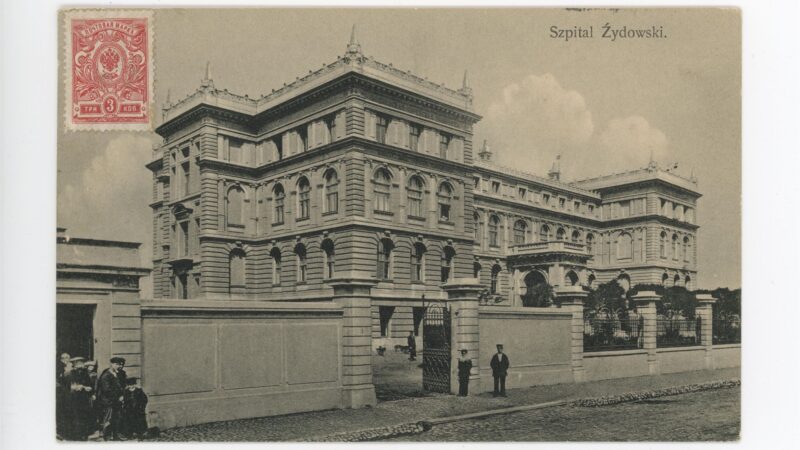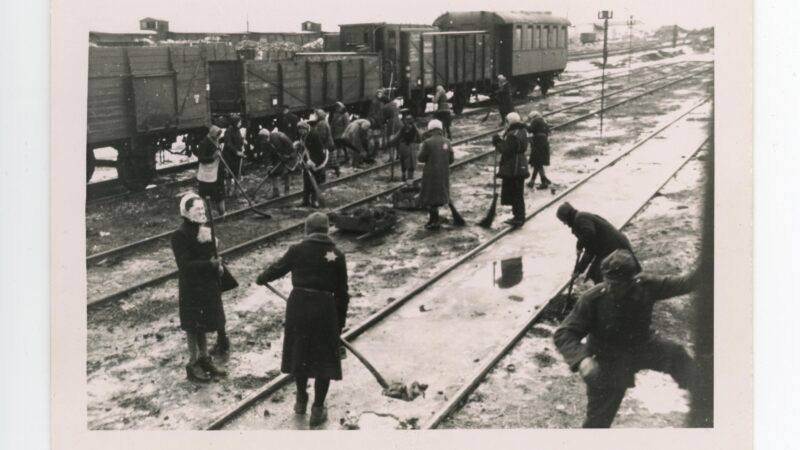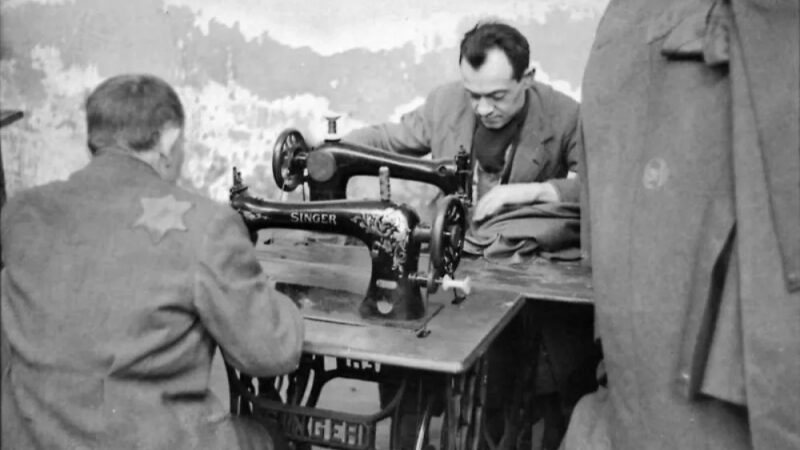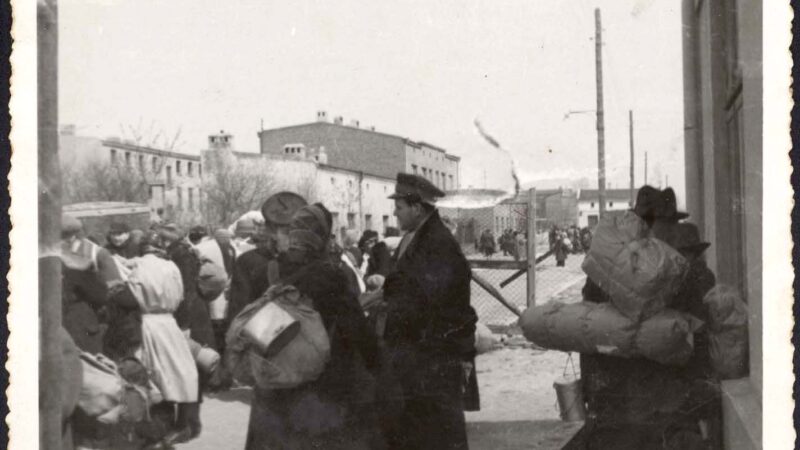‘The Streets appeared to have died out’: The Łódź Ghetto and its annihilation in August 1944
The first Jews moved to Łódź in the late eighteenth century. Their accelerated influx to the city, however, began in the 1860s, with the rapid growth of the local industrial sector.
Initially, it was mainly the inhabitants of the neighbouring towns who migrated to Łódź, followed by Jews living in more distant regions of the Kingdom of Poland and in the Russian Empire. They were attracted primarily by the city’s rapid industrial development, which offered employment opportunities and created prospects for entrepreneurship. Jews settled in large numbers within the administrative boundaries of Łódź, but also in Bałuty, which was only formally incorporated into the city in 1915. At the beginning of the twentieth century, half of Łódź ‘s industrial plants had Jewish owners. However, a vast majority of the city’s largest factories belonged to Germans, and the overwhelming number of Jews living in Łódź were born in the city, working in retail or small workshops.
After Warsaw, interwar Łódź had the largest concentration of Jews in Poland. Just before the outbreak of World War II, 233,000 Jews lived there, out of a population of about 670,000. In 1918–39, Łódź was not developing as dynamically as before the First World War. The economic situation deteriorated, partly because after Poland regained independence and the Bolsheviks siezed power in Russia, it became impossible for Łódź businesses to export goods to the Russian market. Nevertheless, Łódź remained a key centre of Jewish social and cultural life. Artists such as Moses Broderson and Jankiel Adler, members of the Jewish literary and artistic avant-garde, were associated with the city. The poet Yitzhak Katzenelson lived there. The Jung Yiddish art group and the Ararat revue and chamber theatre were active.
German troops invaded Łódź on 8 September 1939. On 9 November the city was formally incorporated into the Reich. The Nazis almost immediately began to introduce anti-Jewish regulations. Many pertained to economics. Jews were forbidden to keep large sums of money, access to savings in bank accounts was blocked, Jewish-owned businesses were seized, and Jewish employees were to be dismissed. Jews’ freedom of movement was restricted, they had curfews, they were prohibited from using public transport or accessing Łódź’s main street, Piotrkowska. Their religious life was also affected, with synagogues being closed or even destroyed. From November 1939, Jews were forced to wear an insignia – Star of David patches on the front and back of their outer garments.
In addition to the discriminatory legal regulations against Jews, beatings, murders and looting followed from day one of the occupation. These were committed by German soldiers and other officers, but also by civilians – Nazi sympathisers recruited from the German inhabitants of Łódź. Jewish community leaders and intellectuals who did not leave the city during the September 1939 campaign were arrested, sent to concentration camps or shot. The terror and the incorporation of Łódź into the Reich prompted many thousands of Jews to leave the city. Others found themselves deported to the General Government. The Germans envisaged the Germanisation of Łódź. This meant the occupation authorities deported both Jews and Poles from the city. The deportations began at the turn of 1939 and 1940. They were interrupted, however, in the face of protests from Governor General Hans Frank.
The first record of the intention to establish a ghetto in Łódź appeared in a document draughted on 10 December 1939 by Friedrich Übelhör, president of the Kalisz Regency, to which Łódź then belonged. The confinement of the Jews in the ghetto was to be a short-term solution, preceding their expulsion from the city. The formal decision to establish the ghetto was taken on 8 February 1940 by the police chief Johannes Schäfer. From 30 April 1940, Jews were forbidden to cross its boundaries.
A special unit was set up in the municipal government of Łódź (renamed Litzmannstadt in April 1940) to administer the ghetto. From autumn 1940 it functioned as Gettoverwaltung. It was headed by Hans Biebow, a businessman from Bremen who had run a large trading company there before the war.
Following the dissolution of the pre-war Jewish organisations, on 13 October 1939, the occupation authorities appointed Mordechai Chaim Rumkowski to be Head of the Jewish Council of Łódź. Rumkowski, a pre-war social and educational activist, was the only member of the Łódź Jewish community board who did not leave the city in September 1939. The German authorities gave him free rein to create the administrative apparatus needed to carry out their orders. Rumkowski began putting it together even before the ghetto was established. He created a Jewish order service, cells responsible for social assistance and food supplies, and for appointing workers for the forced labour the Germans demanded.
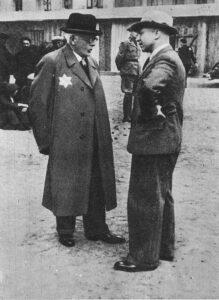
Chaim Rumkowski talking to Hans Biebow (public domain)
During the ghetto’s creation period, the Housing Department became another key institution, allocating accommodation to people removed from other parts of Łódź to the ghetto. These relocations were initially carried out in a systematic manner. By the end of February, when the Germans decided that they were proceeding too slowly, they began to organise raids on Jews who had not yet moved into the ghetto. The most tragic days came on 5 and 6 March 1940, when armed groups of Germans dragged Jews out of their flats. At least 200 people were shot dead.
The Łódź ghetto measured over four square kilometres. It covered the Old Town, Bałuty and Marysin, mostly – poor and neglected parts of the city. The ghetto was surrounded by a wooden fence and barbed wire. Every 50–100 metres Schupo German Police posts were set up. Buildings near the ghetto boundary were demolished. Approaching the fence was forbidden. It is estimated that during the ghetto’s existence about 180 Jews were shot for coming too close.
The ghetto was isolated. There were limited opportunities for contact with the outside world, to escape or smuggle food.The ghetto administration was constantly expanding. At its peak, in August 1942, it employed almost 14,000 people. Civil registration records were kept, internal currency was issued, health care, cultural life and the educational system were organised. Elementary and secondary schools were in operation. there was a court and a prison.
The Head of the Jewish Council of Łódź saw the ghetto’s chance of survival in maximising its production. The Central Bureau of Labour Ministries supervised the manufacturing plants operating there. At the end of 1943, there were nearly 120 factories (‘departments’) in the ghetto, employing almost 74,000 workers. They carried out orders from the Wehrmacht and from large German companies.
At the beginning, more than 160,000 people were imprisoned in the ghetto. In the autumn of 1941, almost 20,000 Jews from Prague, Vienna, Luxembourg, Berlin, Dusseldorf, Frankfurt am Main, Hamburg, Cologne and Emden were sent there, as well as almost 3,000 from Kalisz and other towns in the Kujawy region. More than 5,000 Romani from Austria were brought as well in November. Including children born in the ghetto, its population reached 210,000.
In December 1941, the extermination camp at Chełmno on the Ner started functioning. Between January and July 1942, this was where the Germans transported and murdered 55,000 people imprisoned in the Łódź Ghetto who were deemed unfit for work. Further deportations to Chełmno were carried out in September. Due to the strict house arrest (Allgemeine Gehsperre) in force from 5 to 12 September, the deportations are referred to as the ‘Great Sperre’. Some 15,700 Jews were murdered at that time, mainly children, people over sixty-five years of age and the sick. From then on, the ghetto in fact became a labour camp. Rumkowski’s influence diminished. The administrative apparatus he created was cut back. The major decisions began to be taken personally by Biebow. Representatives of the Gettoverwaltung appeared in the ‘labour resorts’, tasked with ensuring production efficiency and quality. Almost 18,000 skilled workers were brought to Łódź from small town ghettos in the Wartheland. Working hours were extended and workers were no longer granted time off. Schools and the health care system were shut down. However, there were no further deportations to extermination camps. In 1943 and early 1944, more than 4,600 people were sent to labour camps, including arms factories in Skarżysko-Kamienna.
On 11 June, Heinrich Himmler issued the order to transform the Łódź ghetto into a concentration camp, and in December, to relocate the production facilities and their employees to the Lublin region. Due to the declining situation at the battlefront for the Germans, and in connection with the dismissal of Odilo Globocnik from his post as SS and Police commander in the Lublin District, the idea of relocating production which had been carried out in Łódź was abandoned. However, preparations for the camp continued. These were opposed by Hans Biebow, who feared the loss to the SS of income derived from the production in the ghetto. He was supported by the Wehrmacht command, who saw the value of goods produced in the ghetto. Eventually, in February 1944, during a meeting between Himmler and the Governor of Wartheland, Arthur Greiser, it was decided that the ghetto would continue to exist for some time, as central to the whole province, but that another selection of its inhabitants would be carried out. Only those employed directly in production vital to the German economy were to be left alive.
Economic arguments become irrelevant as the Red Army approached Łódź. In June 1944, with 75,000 people still left in the ghetto, the extermination centre at Chełmno nad Nerem resumed its operations. Between 23 June and 14 July, almost 7,200 people were taken there in ten transports from Łódź and murdered. The deportations were briefly interrupted, but they resumed in early August. Both Biebow and Rumkowski appealed to the ghetto population to come forward voluntarily. They were assured the aim of the operation was to relocate factories deep into the Third Reich, where their workers could count on decent treatment. The calls were ignored. The ghetto dwellers tried to hide. From 9 August onwards, German police and armed fire brigades began blockading individual streets and capturing their inhabitants. The distribution of food cards was also suspended so that hunger would force people to show themselves.
An anonymous diarist, probably a teenager employed in the lingerie and clothing department, noted: ‘Today at eight o’clock the Action started. At nine o’clock they came to our street. Shouts of “We’re tearing everything down”. […] Oh, what terrible hours we lived through. The Germans knocked and we did nothing, sitting quietly, our hearts pounding. They tore off the doors of all the neighbours’ homes to see if people were hiding there. They looked into the trees to see if people were hiding up there. They shouted. They ordered people to leave. From nine to twelve we sat without moving. My God, no one knows what will happen to us.’
The deportees were taken to Auschwitz II Birkenau, where the overwhelming majority were sent directly to the gas chambers. It was most likely on 29 August, the last day of these deportations, that Rumkowski and his family were taken to the camp. We do not know the exact circumstances of his death.
Jakub Poznański, one of those who ignored the call to turn up for deportation, noted on 28 August: ‘On Saturday evening I went out into the city. The ghetto looked incredible. The streets seemed to have died. Here and there one might see a person creeping towards the Department of Provisions’. In the following months, he would meticulously count the days he stayed in his hiding place in his diary…
Around 1,400 people were left in the ghetto after the deportations. 600 of them were then transported to forced labour in October 1944. Most of them survived the war. Another group, more than 800 people, formed a ‘clean-up squad’ to sort the belongings left behind by the deportees and tidy up the ghetto area. The Germans planned to execute its members, but were unable to do so. In addition to the members of this squad, probably about 100 people waited until the Red Army’s entry into Łódź in ghetto hiding places. It is estimated that, including the Auschwitz survivors and those previously sent to labour camps, between 5–7,000 people may have survived the Łódź ghetto.


